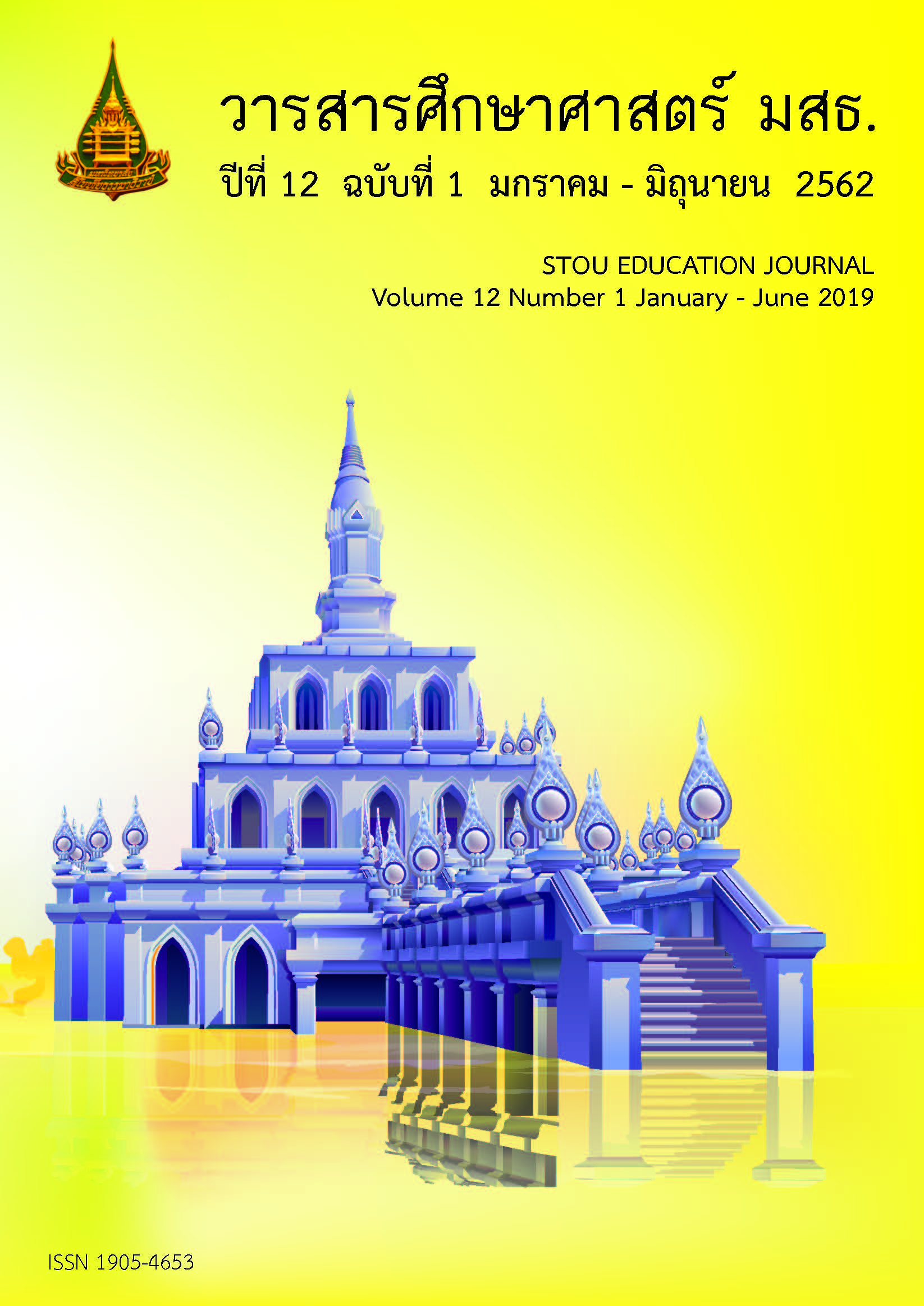An Application of the Open Approach Teaching for Thai Literature to Access to Values of Literature and Aesthetic of Thai Language: A Case Study of Grade 6 Students, Plearnpattana School
Main Article Content
Abstract
The purposes of this study were to 1) analyze the method of teaching Thai literature by applying the Open Approach Teaching to inspire the students to access the values of Thai literature and the aesthetic of Thai language; and 2) evaluate the results of access the values of Thai literature and the aesthetic of Thai language of the students after applying the Open Approach Teaching. A sample was 21 grade 6 students from Plearnpattana School from the academic year of 2015. Research instruments were 10 Open Approach teaching plans in Thai literature class, observation form, behavior recording form, learning outcome recording form and creative evaluation form of the beauty of Thai language. The research results revealed that teaching Thai literature by applying the Open Approach Teaching allowed the students to assess to the value of Thai literature and the aesthetic of Thai language. For the accessibility to the value of Thai literature, three students (14.28%) exhibited a level of habit formation. Three students (14.28%) showed a level of value system. Fifteen students (71.43%) were able to reach a level of appreciation. For the accessibility to the aesthetic of Thai language, seven students (33.33%) exhibited the level of habit formation, five students (23.8%) exhibited the level of value system and nine students (42.85%) were able to reach the level of appreciation. All of the steps in the Open Approach Teaching are crucial for the accessibility of the students to the value of Thai literature and the aesthetic of Thai language. The learners were able to absorb, learn and synthesize their knowledge while the teacher inspires and reflects each learner.
Article Details
References
กระทรวงศึกษาธิการ. (2552). หลักสูตรแกนกลางการศึกษาขั้นพื้นฐาน พุทธศักราช 2551. กรุงเทพฯ: กระทรวงศึกษาธิการ.
ชัยวัฒน์ สุทธิรัตน์. (2553). เทคนิคการใช้คำถามพัฒนาการคิด. นนทบุรี: สหมิตรพริ้นติ้งแอนพลับลิสซิ่ง.
ทิศนา แขมมณี. (2553). ศาสตร์การสอน: องค์ความรู้เพื่อการจัดกระบวนการเรียนรู้ที่มีประสิทธิภาพ. (พิมพ์ครั้งที่ 13). กรุงเทพฯ: สำนักพิมพ์แห่งจุฬาลงกรณ์มหาวิทยาลัย.
พระมหาวิชาญ สุวิชาโน. (2558). การศึกษาแบบองค์รวม. สืบค้นจาก http://www.vitheebuddha.com/main.php?url=news_view&id=491&cat=C.
พรทิพย์ ศิริสมบูรณ์เวช. (2547). การพัฒนาพัฒนารูปแบบการเรียนการสอนวรรณคดีไทยตามทฤษฎีการตอบสนองของผู้อ่านเพื่อเสริมสร้างความสามารถด้านการตอบสนองต่อวรรณคดี การอ่าน เพื่อความเข้าใจ และการคิดไตร่ตรองของนิสิตระดับปริญญาบัณฑิต. (วิทยานิพนธ์ครุศาสตรดุษฎีบัณฑิต สาขาหลักสูตรและการสอน ไม่ได้ตีพิมพ์). จุฬาลงกรณ์มหาวิทยาลัย, กรุงเทพมหานคร.
ไมตรี อินทรประสิทธิ์. (2555). ลักษณะหนึ่งของการปรับใช้การศึกษาชั้นเรียนในประเทศไทย: การออกแบบหน่วยการเรียนรู้. ในเอกสารประกอบการจัดกิจกรรมการเปิดชั้นเรียน (open class) ระดับชาติ. (7 - 22). ขอนแก่น:มหาวิทยาลัยขอนแก่น.
วัชรพล วิบูลยศริน. (2556). นวัตกรรมและสื่อการเรียนการสอนภาษาไทย. กรุงเทพฯ: บริษัทวี พริ้นท์ (1991) จำกัด.
วิจารณ์ พานิช. (2556). สนุกกับการเรียนในศตวรรษที่ 21. กรุงเทพฯ: มูลนิธิสดศรี-สฤษดิ์วงศ์.
ศิธรา จุฑารัตน์. (2549). ผลของการใช้รูปแบบการเรียนการสอนแบบตกผลึกที่มีต่อผลสัมฤทธิ์ทางการเรียนวิชาวรรณคดีไทยและความสามารถทางการอ่านอย่างมีวิจารณญาณของนักเรียน ระดับชั้นมัธยมศึกษาตอนต้น. (วิทยานิพนธ์ครุศาสตรมหาบัณฑิต สาขาวิชาการสอนภาษาไทย ไม่ได้ตีพิมพ์). จุฬาลงกรณ์มหาวิทยาลัย, กรุงเทพมหานคร.
สถาบันอาศรมศิลป์. (2560). กรอบแนวคิดการจัดการเรียนรู้แบบองค์รวม. สืบค้นจาก http://arsomsilp.ac.th/th/wp-content/uploads/2017/08/Arsomsilp-Heart-hand-head-01.jpg.
สอางค์ ดำเนินสวัสดิ์. (2539). จะสอนภาษาไทยให้สนุกได้อย่างไร. (พิมพ์ครั้งที่ 2). กรุงเทพมหานคร: สำนักพิมพ์แห่งจุฬาลงกรณ์มหาวิทยาลัย.
สาริศา ชุ่มมงคล. (2552). ผลการใช้รูปแบบการสอนแบบโฟร์แมทโดยเน้นเทคนิคผังกราฟิกในการสอนวรรณคดีไทยสำหรับนักเรียนชั้นประถมศึกษาปีที่ 6. (วิทยานิพนธ์ศึกษาศาสตรมหาบัณฑิต สาขาการสอนภาษาไทย ไม่ได้ตีพิมพ์). มหาวิทยาลัยเชียงใหม่, เชียงใหม่.
แอมโบรส ซูซาน เอ. (2556). การเรียนรู้แห่งศตวรรษที่ 21: 7 หลักการสร้างนักเรียนรู้แห่งอนาคตใหม่. กรุงเทพฯ : โอเพ่นเวิลด์ส พับลิชชิ่ง เฮ้าส์.

